The Philippine Eagle is in the family Accipitridae. This includes hawks, kites, and old-world vultures. It can grow to about three feet long. This bird is one of the largest animals in the jungle. They are brown with feathers on their head that look like hair. They have yellow eyes with black pupils. This makes them hard to spot in the wild because humans hunt them to eat livestock or their eggs.
The Philippine Eagle is endangered, and there are not many alive. There are many reasons for this, but one of the main issues is that humans hunt them. Another reason is that they cannot find food because animals are in their territory.
People have been destroying the Philippine jungle’s natural habitat by cutting down trees and building roads. This means these species can’t find their food anymore because many animals have disappeared. This bird was found across the Philippines Islands until people started destroying their homes.
- Status: Critically endangered
- Known as: Philippine Eagle, Monkey-eating eagle
- Estimated numbers left in wild: 250 to 750 birds
Description
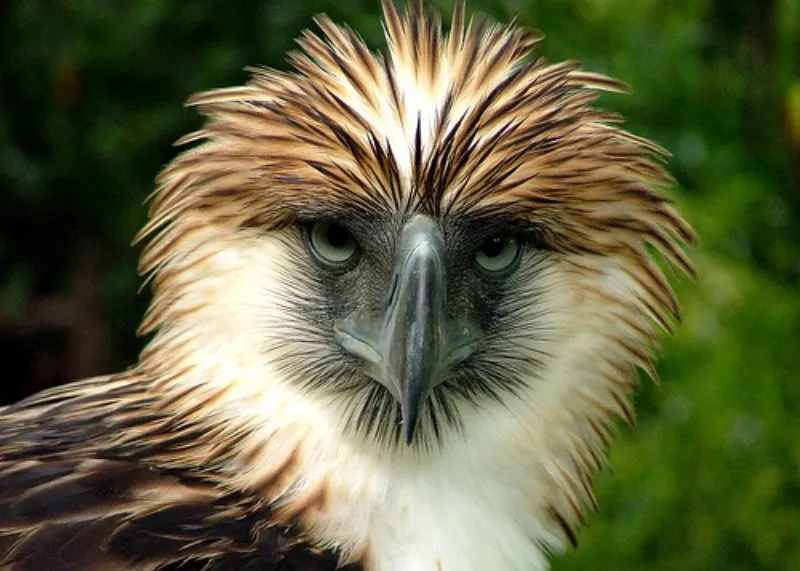
The Philippine eagle is the world’s largest eagle with a wingspan of up to 2 meters, a body length of 90 centimetres, and a weight of 4.5 to 8 kilograms.
In addition to its size, the Philippine eagle is also distinguished by what might be called a ‘mane’ of brown and white feathers on its head. This mane can be raised or lowered at will. The underside of this eagle is white except for the primary and secondary wing feathers and tail, and the upper side is dark brown. The beak and facial mask are black.
Diet
As the Philippine eagle’s alternative names suggests, it eats monkeys and other small primates (including flying lemurs) as its preferred diet.
However, the Philippine eagle also eats bats, snakes, flying squirrels, and rats. These eagles have also been known to take small deer. They will hunt either alone or in pairs, using one of the eagles as a distraction while the second is able to ambush the prey.
The Philippine eagle is monogamous, with pairs mating for life. However, if one of the pair dies, the surviving eagle will usually find another companion.
A pair of these eagles requires about 100 square kilometers of territory, although there is usually some territorial overlap between pairs.
While larger birds of prey are usually proportionately slower than hawks, the Philippine eagle’s flying speed corresponds more closely to the faster hawks.
Breeding
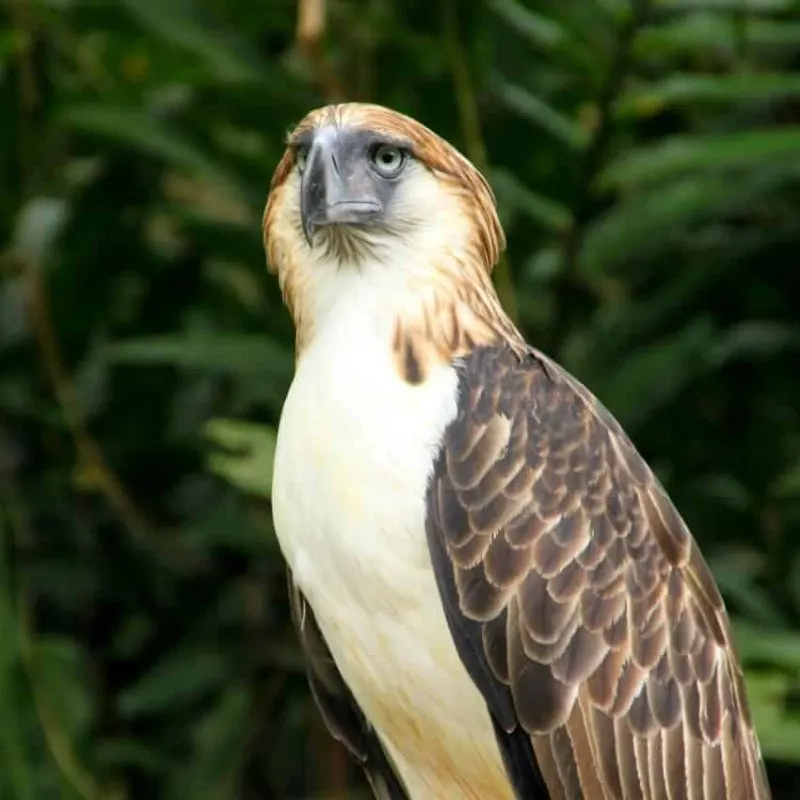
Breeding season for the Philippine eagle occurs in September, and a nest is built high in the jungle’s canopy. The pair produces only one egg, and this chick will remain with the parents for approximately one year. Due to the time involved in rearing the young, these eagles only nest every two years.
Location
As this eagle’s name indicates, it is found exclusively in the Philippines and only on Luzon, Leyte, Mindanao, and Samar islands. The majority of these birds are found on the island of Mindanao.
Philippine eagles prefer to live in dense woodland and avoid open forests and grasslands. However, its range includes lowland forests and heavily wooded zones in higher elevations, and it has been found at 1,800 meters. This eagle actually prefers areas with a steep landscape.
About Philippine Eagle
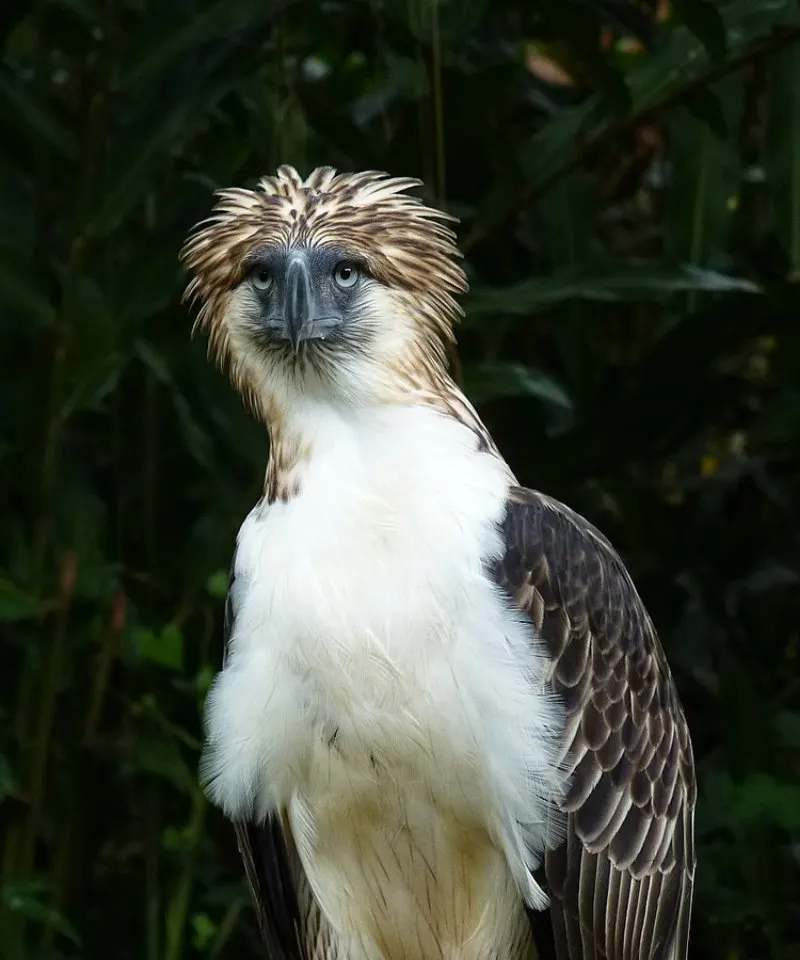
Philippine Eagles are birds that are endangered and very large. They can grow up to 3 feet long and have brown feathers on their head, making them look like hair from a distance. Their eyes are yellow with black pupils, which makes it hard for hunters to spot them in the wild.
The Philippine Eagle is indigenous to the Philippines. It is hunted for meat and eggs, as well as trees being cut down, making it difficult to find food. Because they are killed by people, and there aren’t enough trees, it is endangered. It used to be discovered in Philippine forests in the past. However, people have been removing trees and building roads.
There are no animals left for Philippine Eagles to eat. This means that they can’t find food. Birds like these are endangered because people destroy and hunt their habitat.
These species are almost extinct in the wild but still exist in zoos. They are brown birds with long feathers on their head that make them look like hair when seen from a distance.
Philippine Eagle Habitat
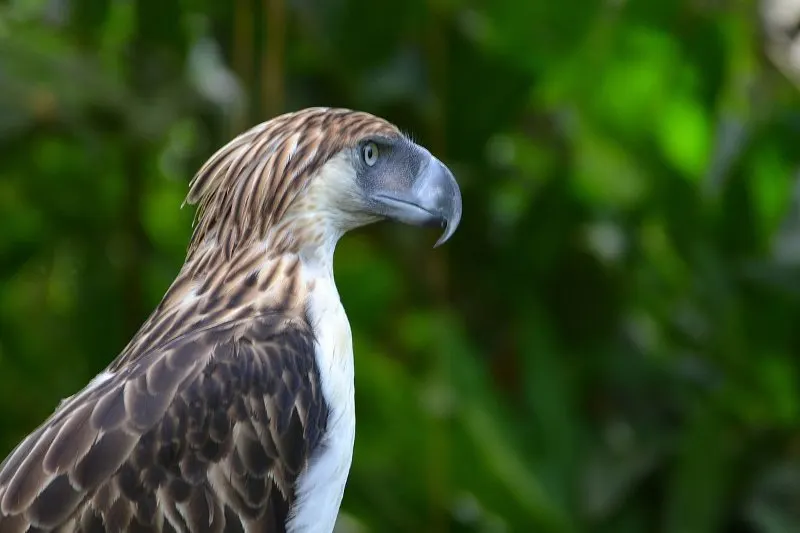
The Philippine eagle lives on four different islands. Mindanao has the greatest number of breeding pairs, with 82 to 233. On Samar Island, there are six pairs, whereas two each can be found on Leyte and Luzon Islands. It’s found in Northern Sierra Madre National Park on Luzon, Mount Apo, Mount Malindang, and Mount Kitanglad National Parks in Mindanao.
Eagles live in forests with dipterocarp and mid-montane trees. They live in steep areas of the forest. The elevation ranges from lowlands to mountains of over 1800 meters (5,900 feet). Only 9,220 km2 of old-growth forest remains in the bird’s range. That is about 2,280,000 acres. The total area that this bird lives in is 146,000 km2 or 56 sq mi.
See Related: Is a Bird a Consumer? Here’s What to Know
Philippine Eagle is endangered
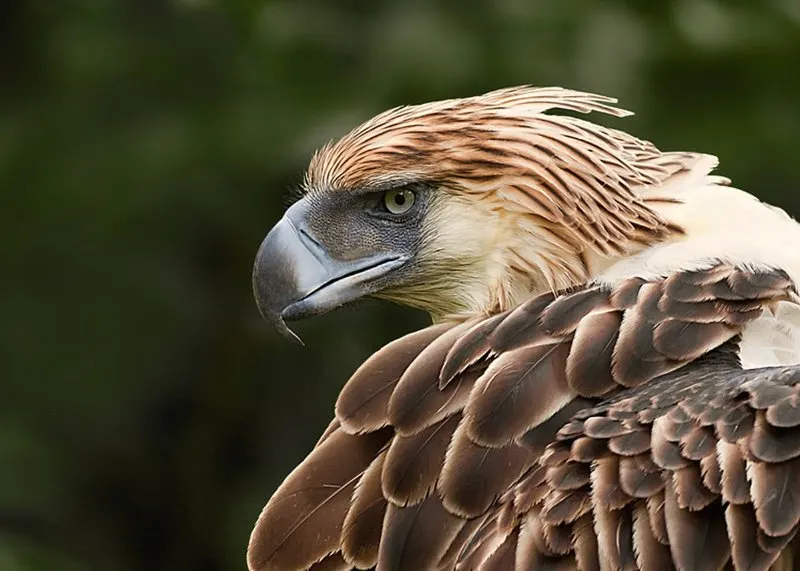
The Philippine eagle is a critically endangered species. In the wild, fewer than 500 birds are remaining. The natural habitat of birds is under threat.
Deforestation has played a role in the species’ population decrease, although one of the most significant reasons is logging since they nest high in the trees and rely on trees for food and shelter.
The Philippine Eagle will usually hunt pigs, monkeys, birds, and insects that live in the trees or near rivers. The species is threatened because of deforestation and poaching. Sellers want to put them in zoos or sell them illegally.
To safeguard these species, their habitats are being preserved to safeguard their natural habitat. The Philippine Eagles are kept in huge cages for a few months before being reintroduced into the wild, so they don’t learn to hunt and consume independently. They are fed until they are released into their natural environment.
The species is being reestablished in its original surroundings. It’s being reintroduced gradually to allow it to learn how to hunt and find food independently. The bird has been successfully reintroduced in different reserves or areas.
See Related: Three-Letter Animals You’ve Probably Never Heard Of
Conservation
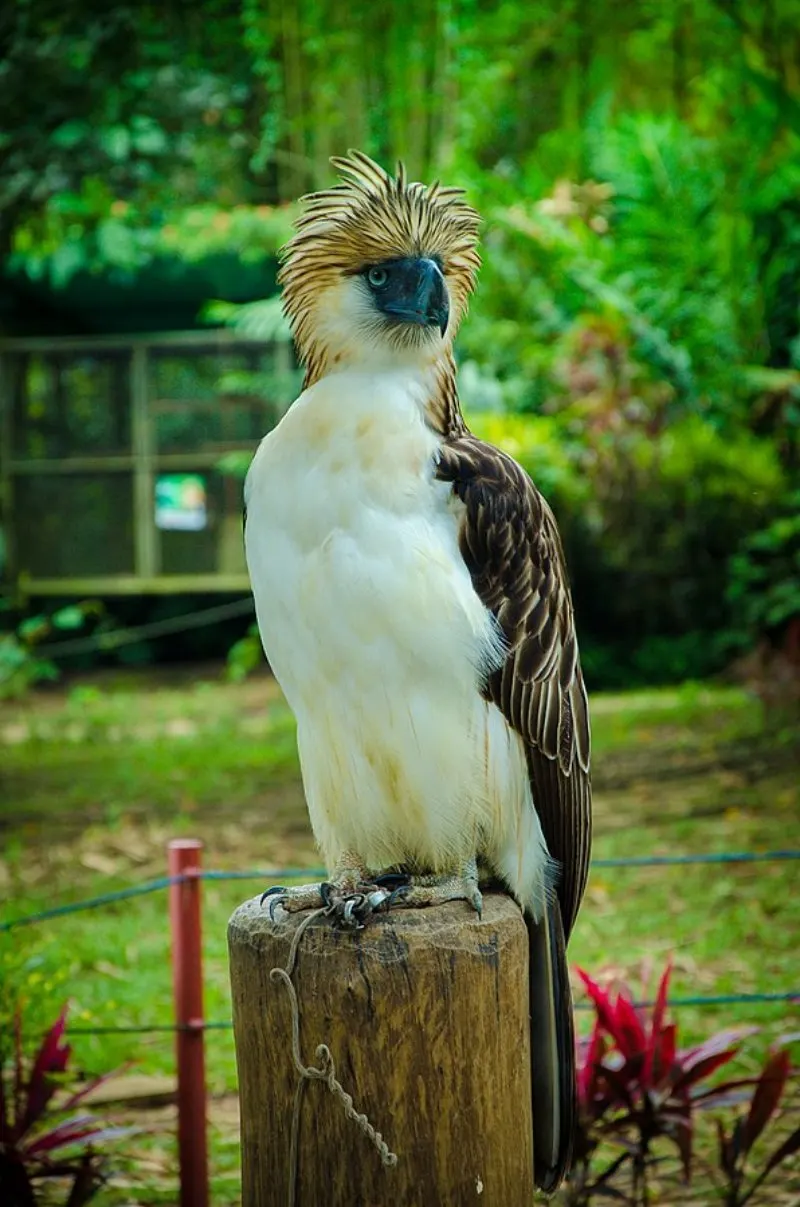
Threats
The greatest threat to the Philippine eagle is habitat destruction. As the Philippine Islands are systematically deforested, the land available to the eagle shrinks yearly.
Logging and agricultural expansion are the major problems, but pesticides and pollution also take a toll, especially as they concern the fertility of the eagles. Poachers still take a few birds, and mining enterprises destroy the forest areas the eagles need.
It has been estimated that only about 10% of the original forestland in the Philippines remains.
Conservation efforts
Several protected reserves offer the Philippine eagle a habitat where it can live a fairly normal existence. Programs have been instituted to provide income for the natives without causing the destruction of the environment.
Legislation prohibits hunting and disturbance of nests, and captive breeding programs are in effect that will hopefully allow for the birds to be reintroduced to the wild.
Organizations
If you know of or are part of an organization that works to conserve the Philippine Eagle, please contact us to have it featured on Our Endangered World.
Conclusion
The Philippine eagle is found only in the Philippines, on Luzon, Leyte, Mindanao, and Samar islands. The majority are found on Mindanao Island. They live in wooded areas. They don’t live in open spaces or fields. But they can live at different levels of elevation. When they hunt, sometimes they will take small animals like deer.
Philippine Eagles are threatened by habitat loss from deforestation, logging, agricultural expansion, pesticides, and pollution, which have been known to take a toll on fertility. There is legislation protecting them from being hunted or disturbed by their nests, but they still face threats from poachers and mining enterprises that destroy their habitat.
The Philippine Eagle is considered critically endangered by the IUCN, with an estimated population of just 400 pairs left in the wild, which is believed to be stable due to Philippine laws protecting Philippine Eagles.
These species are not at risk. But they might become endangered if their habitat continues to be taken away or if they are hunted. It is illegal to hurt or capture Philippine eagles. They are fully protected under Philippine law and the Philippine Wildlife Act of 1998.
There are three places in the Philippines where people can see Philippine Eagles. One is at the Philippine Eagle Foundation in Davao City. Another place is at Malagos Garden Resort in Lipa, Batangas. The third place is in Cebu City, the Philippine Eagle Conservation Centre. These birds can also be found in zoos worldwide, like those in Hawaii and South Korea.
The Philippine Eagle is a type of bird in the family of birds that includes hawks, kites, harriers, and Old World vultures. The bird is the largest one from this family. They have wings that are long and wide. They also have shorter tails than other large eagles because they live in the forest without much space for free flight.
The Philippine Eagle has sharper eyesight than most people, and they have dark circles around their eyes that help them hunt animals during the day. They also have powerful feet with long nails to grip prey.
FAQs
What are Philippine Eagles?
Philippine Eagles, scientifically known as Pithecophaga jefferyi, are unique organisms. Contrary to the description, they are not gill-bearing aquatic craniate animals that lack limbs with digits. This majestic bird is known as the Monkey-eating Eagle or Great Philippine Eagle.
Is the Philippine Eagle Endangered?
The species is critically endangered, with over half of the remaining nesting pairs found in the uncontrolled forest on Mindanao Island. Despite being recognized as the national bird of the Philippines, the Philippine Eagle faces endangerment due to the destruction of nesting sites brought about by deforestation, intentional ensnarement in traps set for wild pigs, and illicit hunting by farmers reacting to the predation of their domestic animals and livestock.
Is Philippine Eagle Compatible With Humans?
The Philippine Eagle may be observed stationed on dead trees in rural areas. The Philippine Eagle has been shown to have adapted to coexisting with humans, although this may also be due to the lack of natural predators.
Where Can I Find Philippine Eagle?
Philippine Eagles inhabit islands within the Philippine archipelago and are often found near areas populated by humans. These birds favor lowland tropical rainforests, where they can soar and prey on monkeys and flying lemurs that inhabit these regions. The majority of Philippine Eagles reside on the islands of Catanduanes, Samar, Mindanao, Luzon, and Dinagat.
These eagles have also been spotted in several Philippine provinces, including Quezon, Palawan, Tawi-Tawi, Sulu, and Basilan. Further, they inhabit forests such as Mount Isarog National Park in Bicol, Mount Kitanglad in Bukidnon, Davao City, and Mount Apo. They have also been sighted in the provinces of South Cotabato and Sarangani. Unfortunately, Philippine Eagles have been forced from their habitats due to various factors, including logging and deforestation.
Other Species Profile
